Learn how to make homemade chicken ravioli without pasta machine with this ultimate guide for homemade ravioli from scratch. Helpful tips and step by step photo instructions are included.
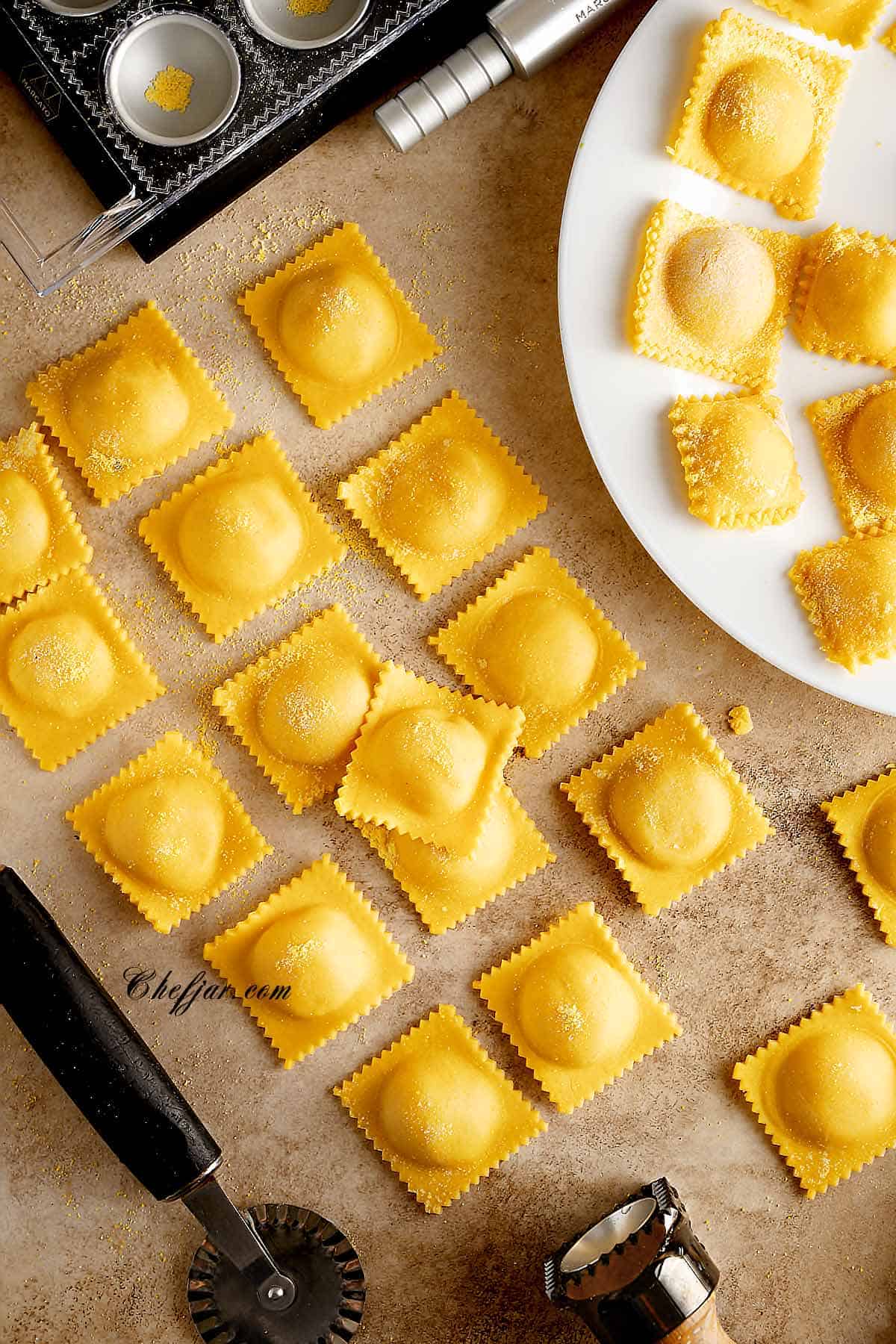
Ravioli
Pretty much everybody loves ravioli. Those little fun-sized pasta parcels are popular pretty much everywhere, and are a staple on many restaurant menus.
Almost every home cook has made ravioli from a package as a last-minute meal or as a freezer staple. Ravioli, like most pasta, freezes very well, cooks easily from the freezer without having to thaw, and it’s easy to cook up a nice sauce as you go. But did you know how satisfying - and how simple - it is to make your own ravioli from scratch at home? You don’t even need a pasta machine, although many Italian families still use a hand-cranked pasta machine to this day. In fact, you can make your own delicious ravioli with just egg, flour, salt, and your choice of filling.
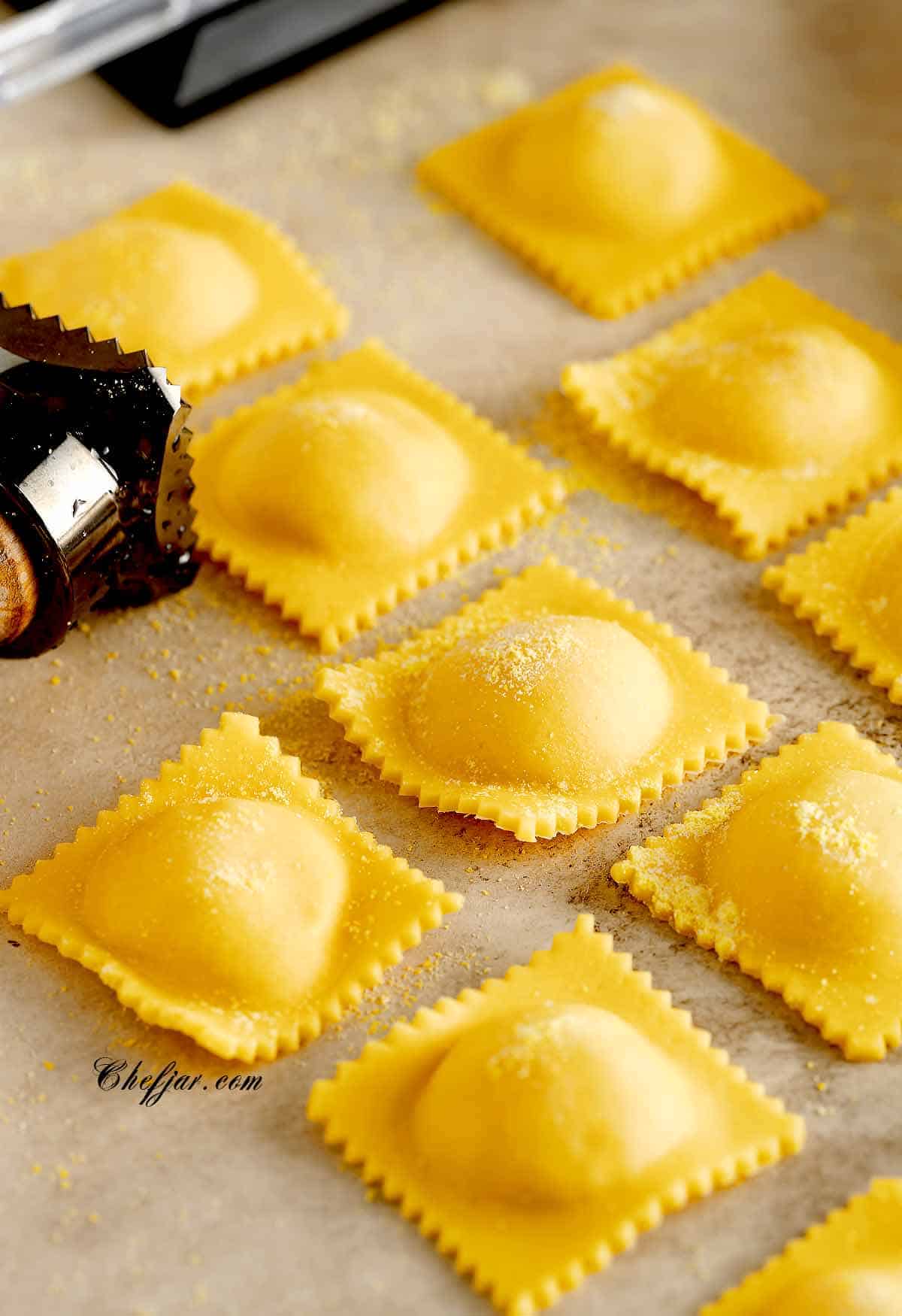
Homemade Ravioli
With this recipe, we’re going over the ravioli-making process. To make ravioli without a pasta machine, we strongly encourage you to use a rolling pin. Before they invented pasta machines, this is exactly how families used to do it. Using a rolling pin might take a little longer, but you’ll have more control over the consistency of your ravioli as opposed to relying on preset thicknesses on a machine.
One of the really cool things about making ravioli is that, although the technique itself is relatively simple, you can refine your skill every time you make this food. In that way, cooking ravioli is not unlike learning to cook as a whole. It’s a classic “deep and narrow” skill that you’ll only improve at as time goes by. You can customize ravioli to your personal taste, using any filling you like, and trying different pasta thicknesses as you go.
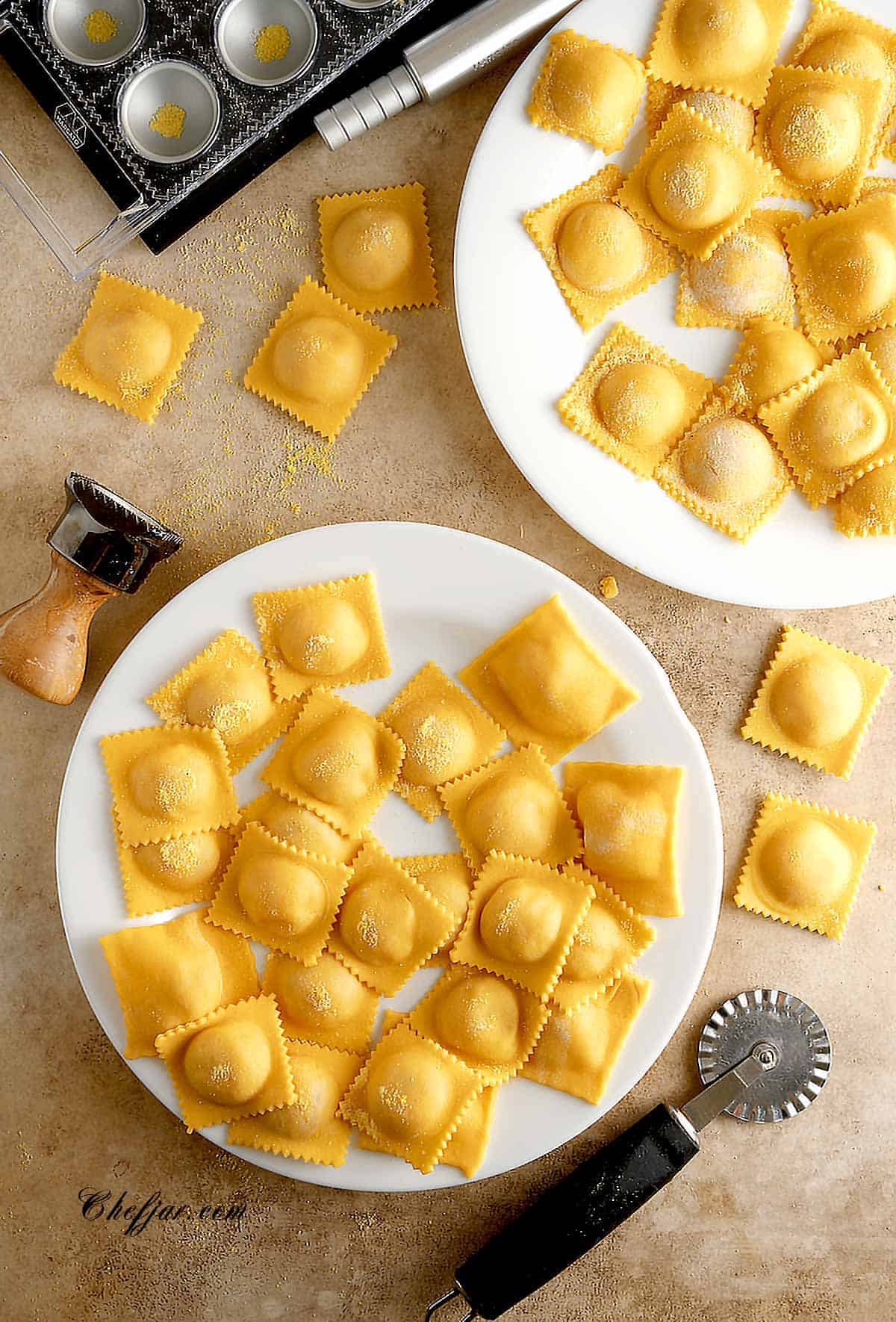
Tools To Make Ravioli
To make fresh ravioli without a pasta machine, you will need one of these tools: a ravioli tablet, ravioli stamp or pasta/ pastry cutter. The choice of the tool will depend on the shape and size you are looking for.
- Ravioli tablet: This is our favorite tool. It is super helpful and allows you to make ravioli just in a few minutes once your pasta sheets are read.
- Ravioli Stamp: There are a great variety of stamps nowadays. They have different shapes and sizes. It is easy to use them. You will need to place the stamp over the filled pasta and stamp. We love marcato stamps.
- Pasta Cutter: It is another great tool for cutting hand filled ravioli. Alternatively you can use a pastry cutter.
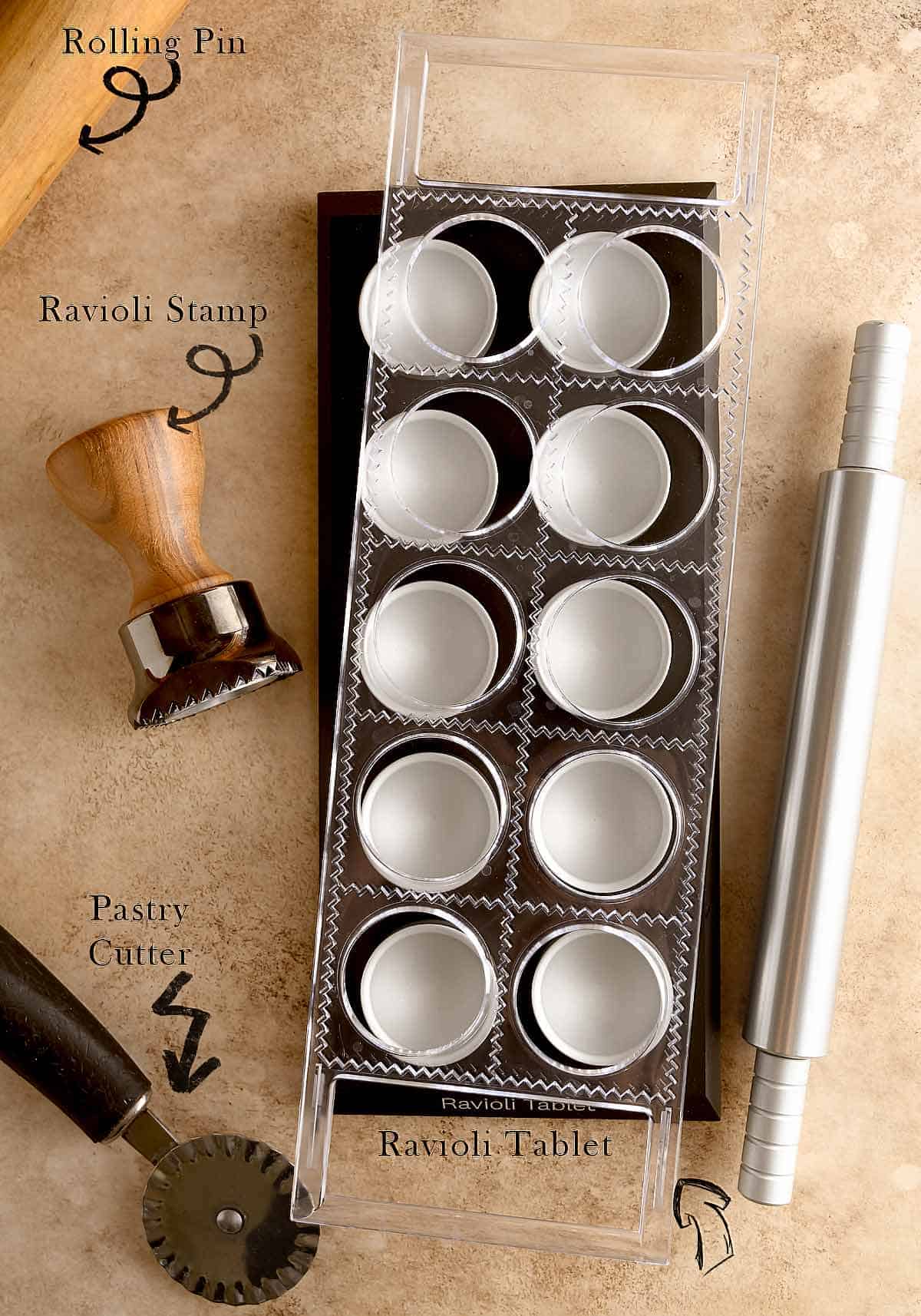
Making Fresh Pasta Sheets without Machine
- In a large bowl mix together eggs and flour using a fork.
Expert tip 1: For the best results, use a flour mixture of 1 cup soft-wheat flour and 1 cup durum wheat flour.
Expert tip 2: Bring the eggs to room temperature as they will make the dough more elastic.
- Use your hands to knead the dough until its completely smooth and elastic. If you find the dough to be too dry, add 1-2 tablespoons water. If it is too soft, add some flour.
- Transfer the dough on the working surface lightly dusted with flour. Cut it into 4-6 pieces.
- Roll each piece of dough to 1/16" thickness. This is the sweet spot for ravioli thickness and will keep the filling secure in its pasta shell, while still adopting the beautifully tender texture we all love in ravioli.
- Lightly dust each sheet with flour on both sides.
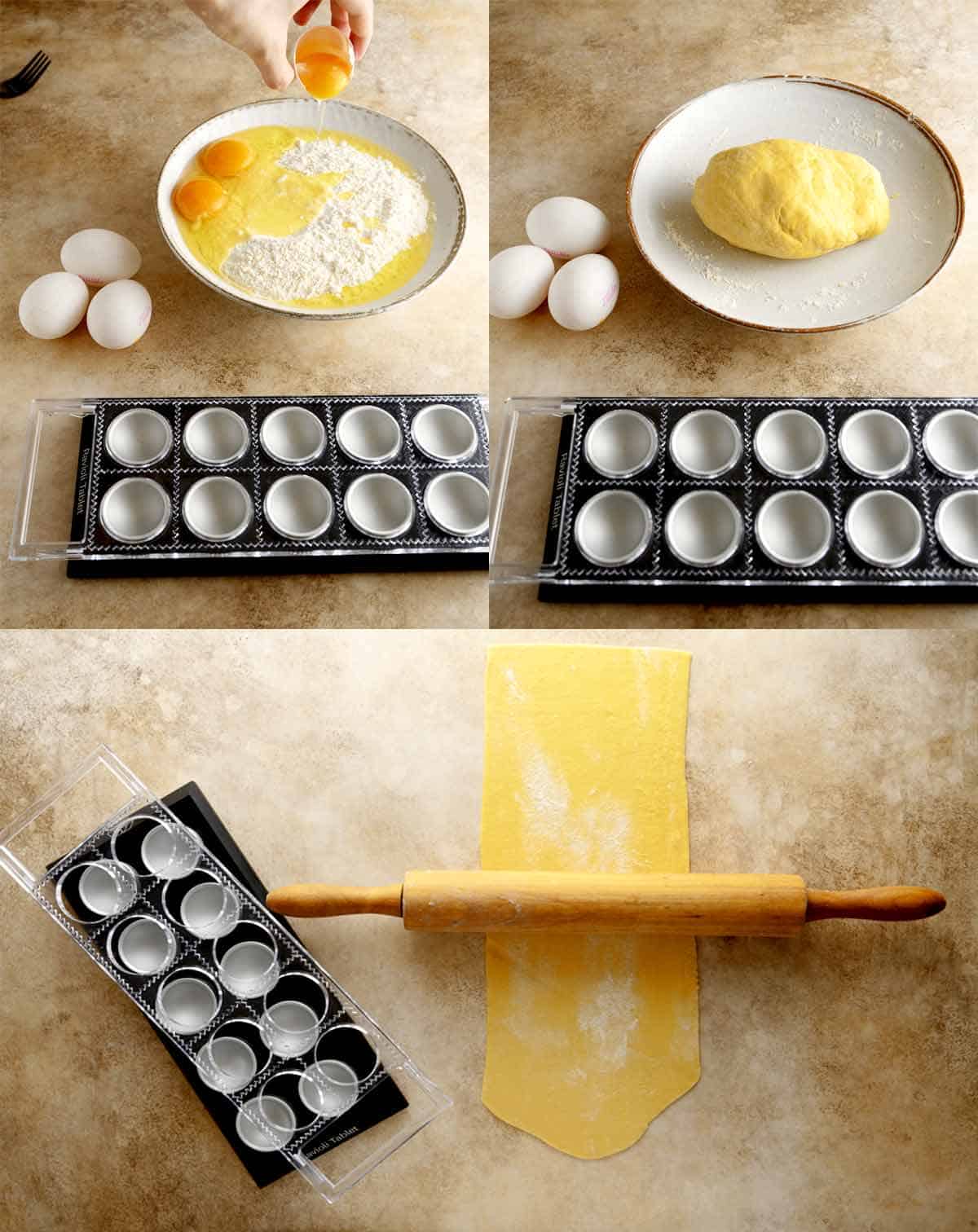
Using a Ravioli Tablet
- Cut the pasta sheets crosswise into 10 inch (25 cm) long. The length with depend on the size of your ravioli tablet.
- Dust your ravioli tablet lightly with semolina or 00 flour to prevent the pasta sticking to it.
- Place the sheet of pasta on the ravioli tablet to cover every mould with the dough.
- Gently press each mould with your finger to make pockets that will be filled with the filling.
- Fill each mould with 1 teaspoon of the filling and press it down with the back of the spoon.
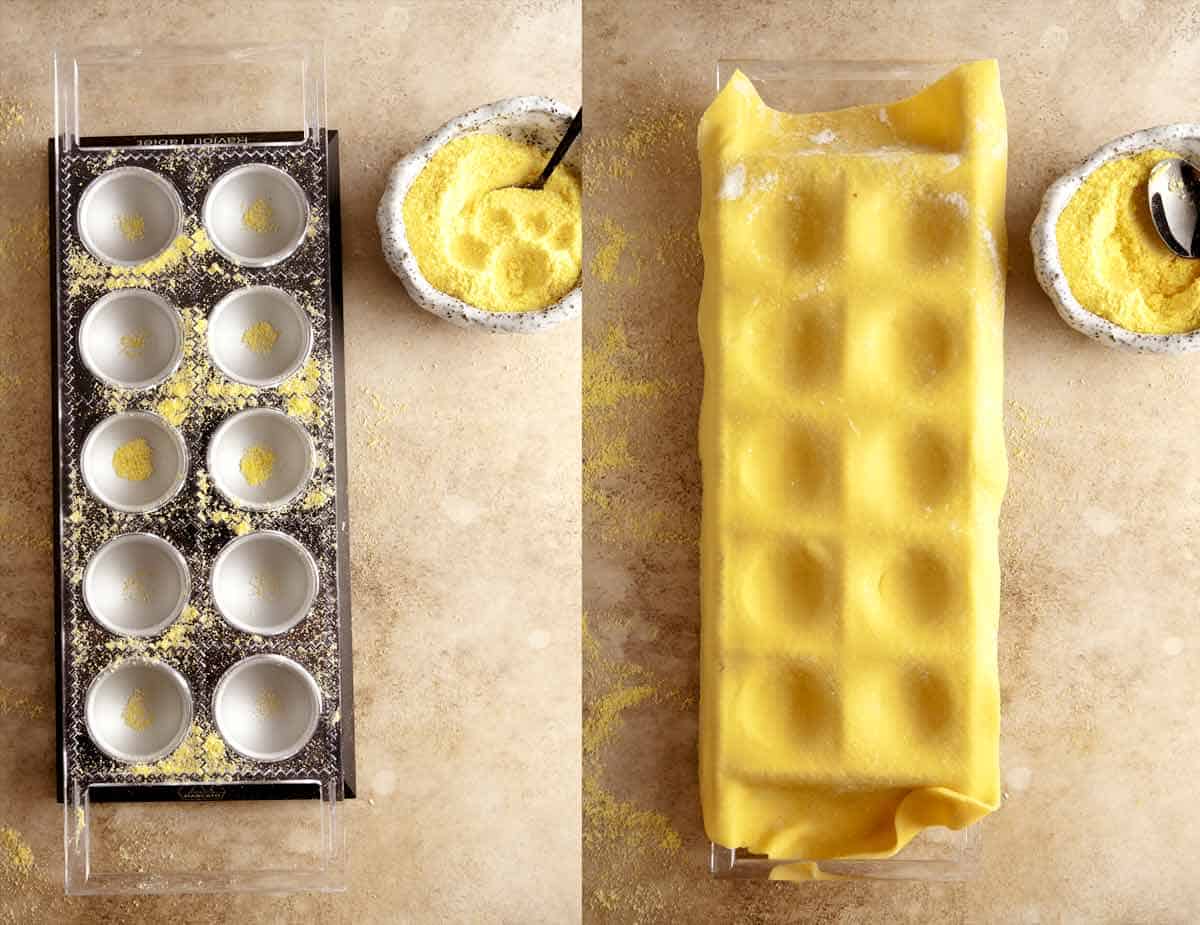
- Place the second sheet of pasta over the ravioli and use your hands to seal the stuffed sheets together.
- Again flour the stuffed sheets before cutting.
- Roll the rolling pin over to cut the ravioli.
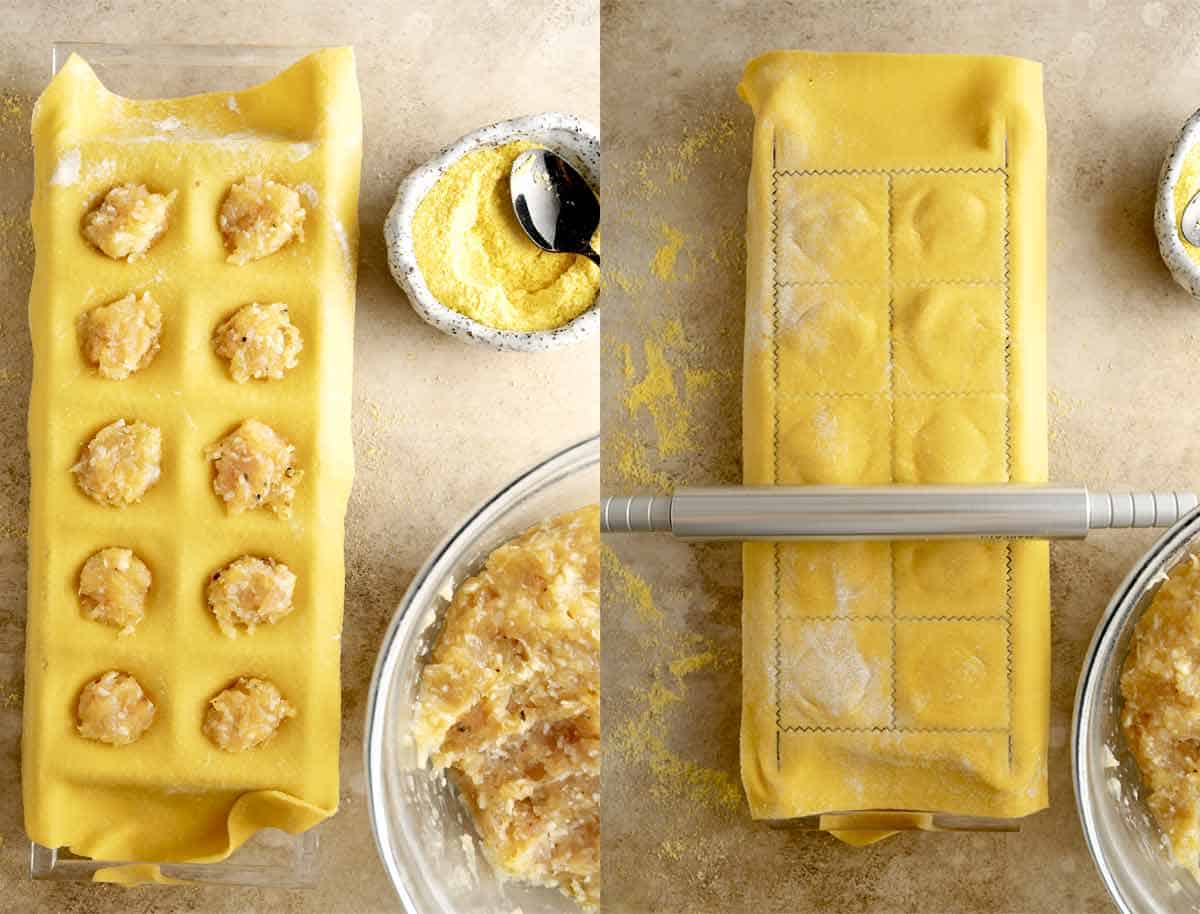
- Remove the excess dough from the sides.
- Turn over the rack. You should have perfectly shaped ravioli ready for cooking!
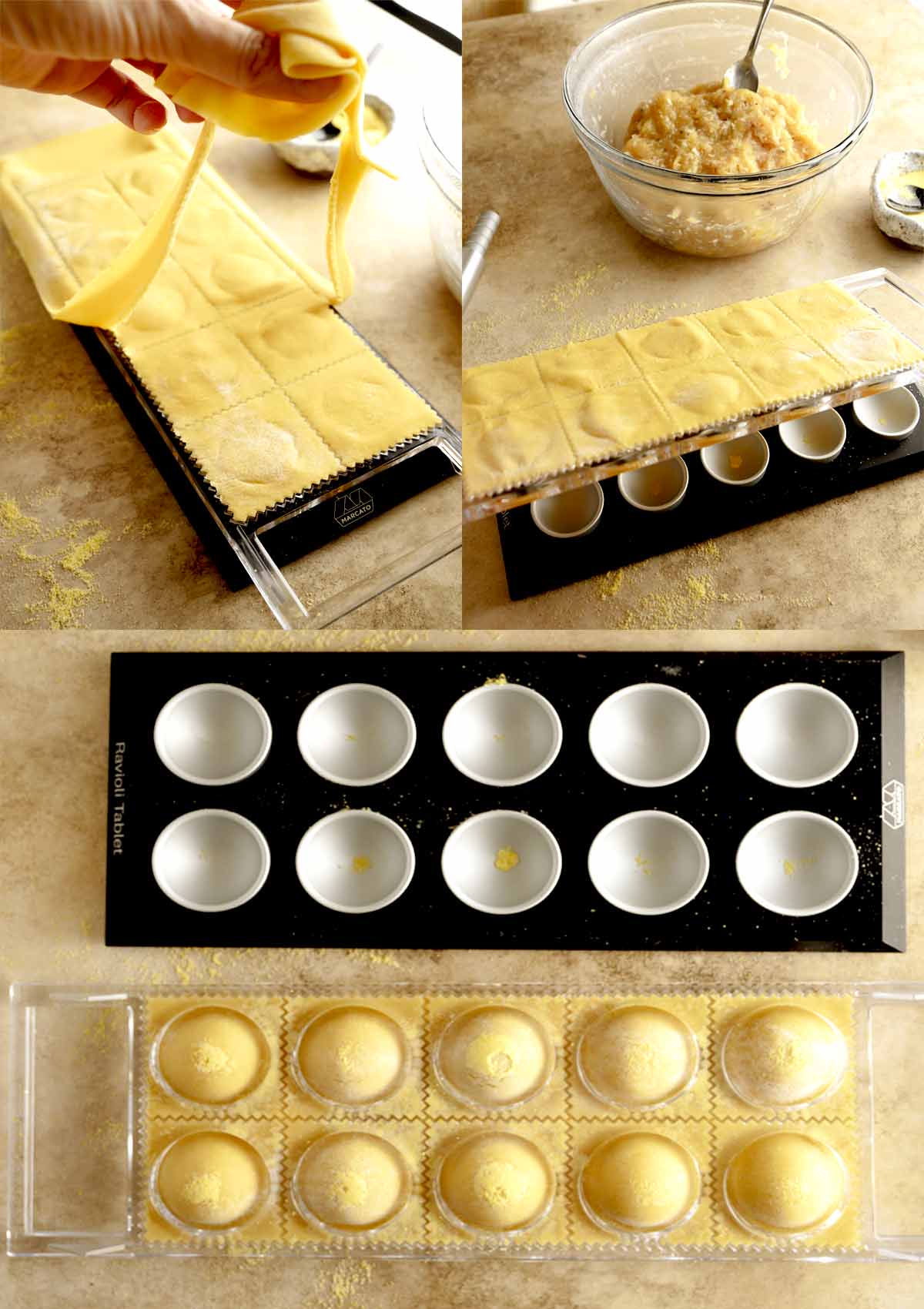
Using a Ravioli Stamp
- Place a pasta sheet on your working surface dusted with flour.
- Gently press your ravioli stamp onto the pasta sheet so you will know where to put the filling. You only want to mark and not cut it.
- Place about 1 teaspoon of the filling in the middle of each ravioli mark.
- Then, lay a second sheet of pasta over the first sheet. Use your hands to shape ravioli. Press and seal the pasta together.
- Finally, use your stamp to cut out each ravioli. You are done!
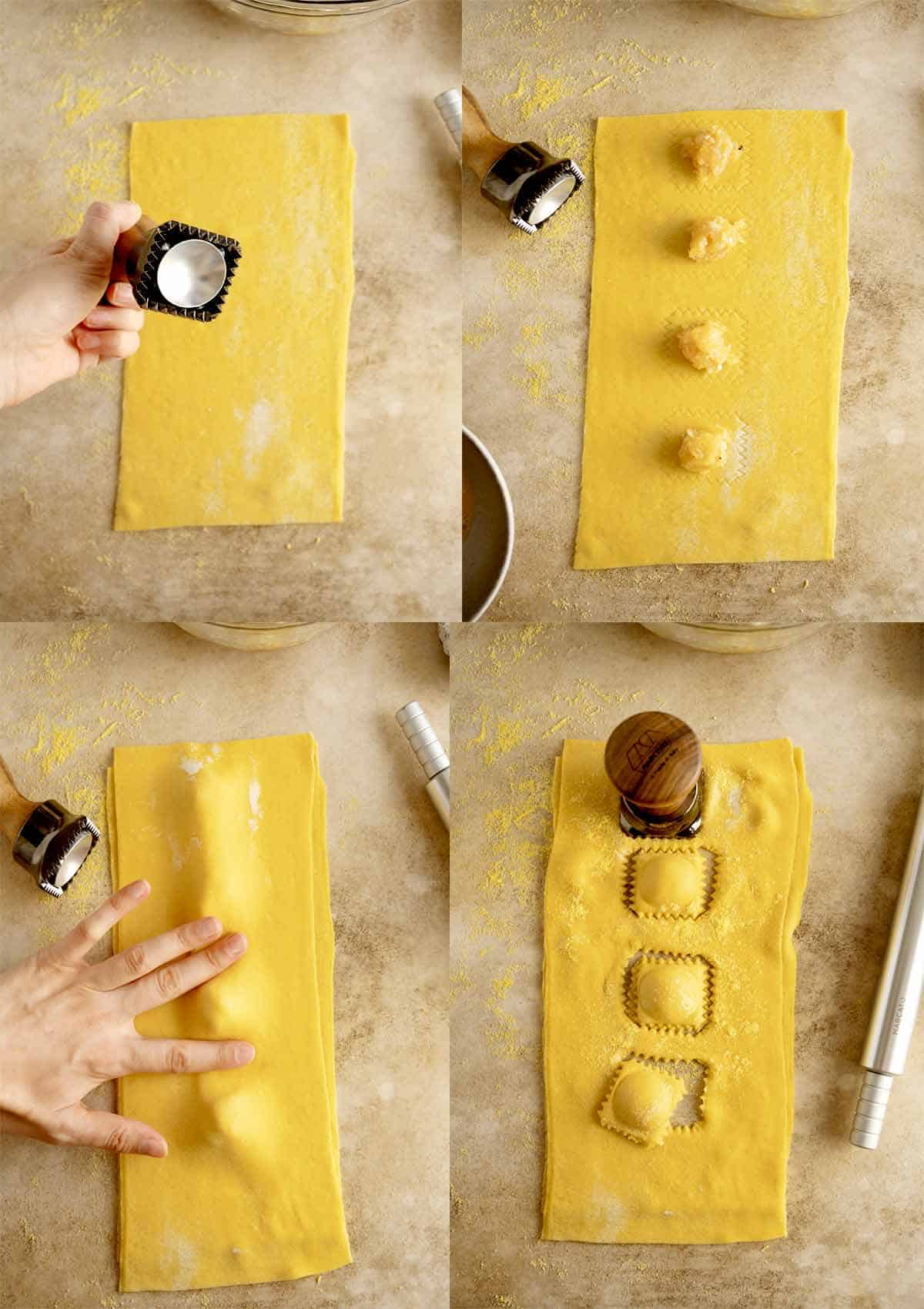
Using a Pasta Cutter
- Place a sheet of pasta on your working surface.
- Space the filling, leaving about 2-in. space. I usually use 1 teaspoon of the filling per ravioli. For larger ravioli go for 1 tablespoon of the filling.
- Brush with egg wash around the filling. This helps with sealing.
- Lay a second sheet of pasta over the first, shape ravioli and seal.
- Use a pasta cutter to cut the sides and cut them into squares.
Expert tip: If you don’t have a pasta cutter wheel, use a pastry or pizza cutter (or even knife). However, you can get the nice crimped edges only with a pasta wheel.
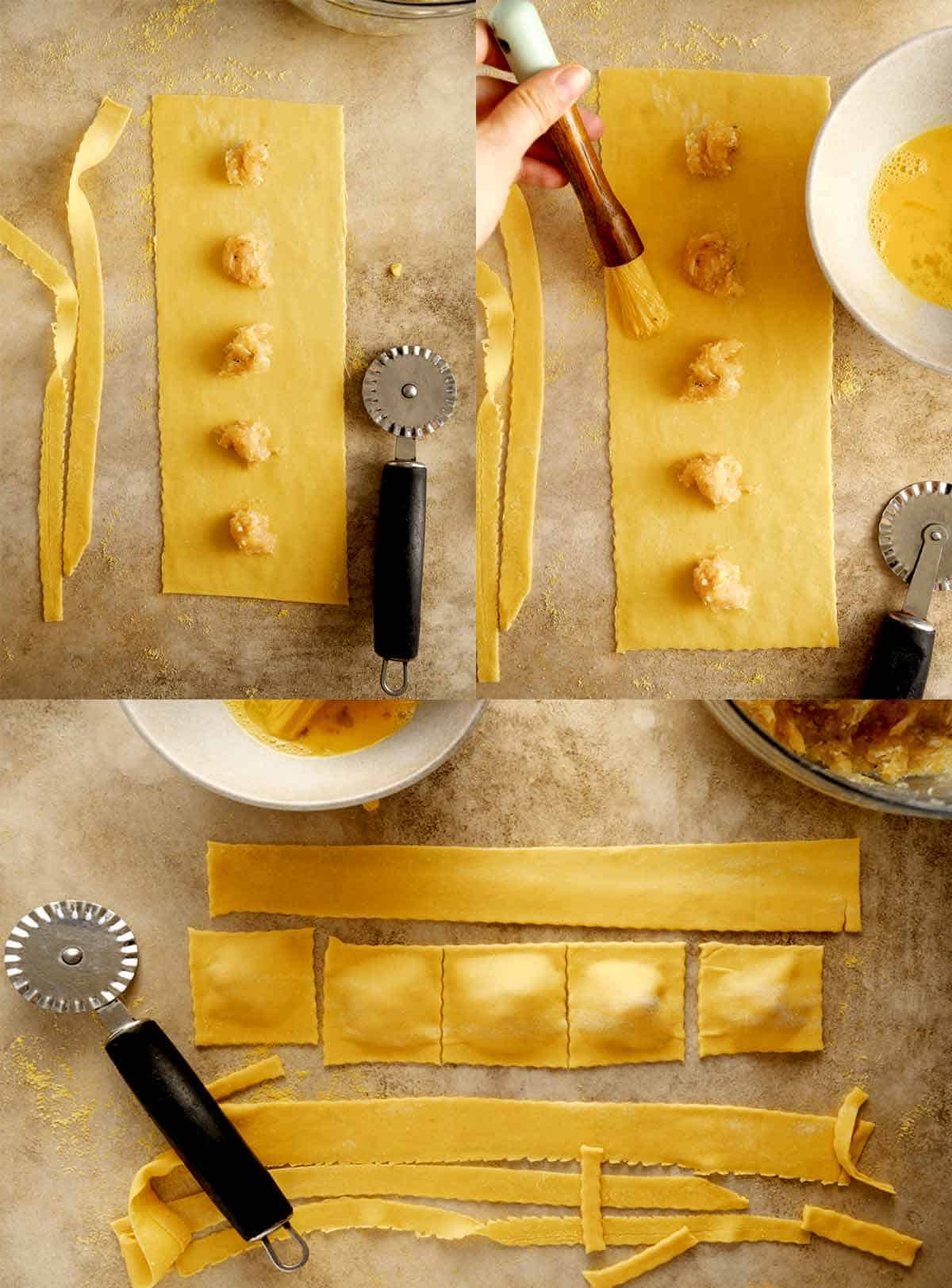
Using a Knife
- Fold your first sheet along its midline, making a light crease, then open it up. Place six evenly spaced teaspoons of your filling about a half inch apart along the lower half of the dough.
- Next, moisten the dough lightly with your water or egg wash and brush, and fold it over, pressing outward from the folded point to push out any trapped air bubbles. Now you’re going to pat the dough down around each lump of filling, creating a seal. Each piece of the filling should now be safely sealed within its setting.
- Now for the fun part! Take a plain old knife, and cut out your ravioli into even squares. Each piece should be roughly identical to the others, but a little difference in size or shape is OK, too. That’s part of the charm of homemade pasta.
Tips for Making Ravioli
Here are some helpful tips for your adventures with ravioli.
- The quality of your dough is very important. Often, the store-bought freezer ravioli you can get at a supermarket lacks the silky, smooth texture of homemade ravioli. Use a fine, high-quality flour and fresh eggs to make your pasta dough and you’ll taste the difference.
- The thickness of your dough is critical. Leave it too thick, and your ravioli skin might be dense and gummy. Too thin and the filling leaks out when cooking. There’s a happy medium that we use in this recipe, and you should stick to it until you’re very comfortable making ravioli.
- Your filling should be more solid than liquid. Watery fillings can leak out of your pasta. They can also affect your dough and make it difficult to work with. A filling with a drier texture is perfect for ravioli
- Be generous with your ravioli filling. You can make the filling to your taste. If you’re seasoning the filling, be generous with the seasoning, and make it flavorful and robust. Ideally, you want the filling to be tasty enough to eat on its own! You want to stuff the dough pretty tightly to cook the ravioli, as well. At least half, up to two thirds, of the area of your ravioli pieces should comprise the filling.
- Eliminate air bubbles in the ravioli where you can. It’s inevitable that a little bit of air will sneak into your pasta parcels, but press out the bubbles you can find. The ravioli will survive having a few bubbles, though, so you can rest easy if there are a few left when it’s cooking time.
How To Cook Homemade Ravioli
One of the great things about ravioli is how easy it is to cook!
Boil a pot of water, reduce the heat to a low boil, and add your ravioli to the pot. You want to salt the water before boiling it. The Italians say pasta water should be as salty as the sea, but you can salt the water to your own preference.
How Long to Cook Fresh Ravioli
Let the ravioli boil for about three minutes, at which point it should be cooked. Ravioli is cooked when the little starchy white line in the centre of a piece - if you slice into it - is barely gone.
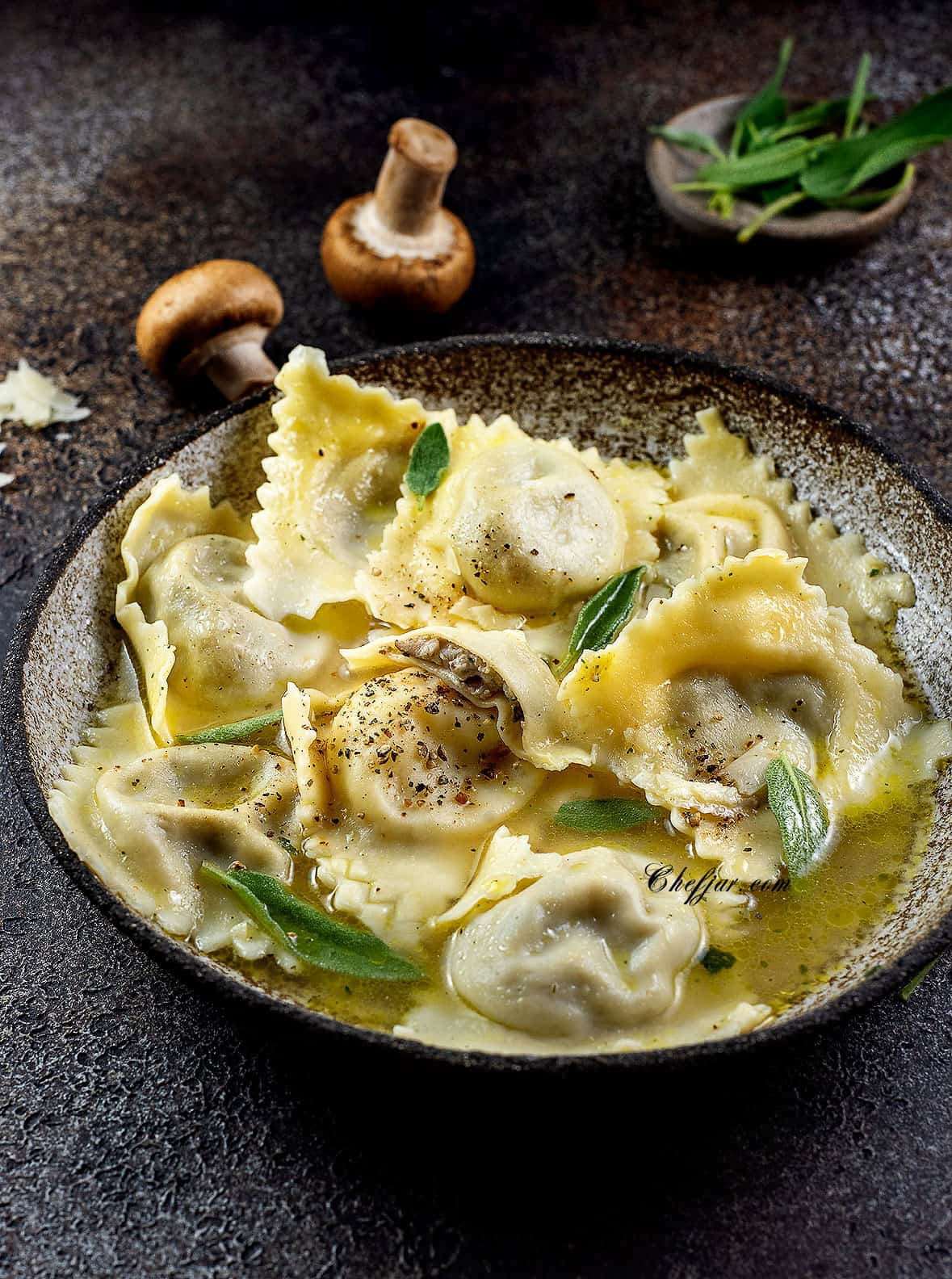
Best Ravioli Sauce
You can serve your ravioli in any sauce you like. Typically, ravioli is served in a relatively light sauce rather than a heavy, chunky ragu. Often, some extra virgin olive oil, freshly grated cheese, and choice herbs are all you need, particularly if you have an especially delicious filling. Browned butter sauces are also popular, or a sauce made with sage and butter. Another classic option is to simply drizzle your bowl of ravioli with some oil before sprinkling with salt and lemon juice. A lot of the time, the flavor in a ravioli dish comes from the ravioli itself, not the sauce. A combination of fresh and savory flavors is a classic combo for any ravioli dinner.
When it comes to ravioli, something straightforward is almost always best.
Love Filled Pasta? Try these!!
Creamy Garlic Butter Sauce for Tortellini
Lemon Butter Sauce for Lobster Ravioli

If you make this recipe be sure to leave a comment or give this recipe a rating ⭐⭐⭐⭐⭐! I will be happy to hear from you!
Print
Homemade Chicken Ravioli Without Pasta Machine
- Total Time: 50 minutes
- Yield: 6 1x
Description
Learn how to make homemade chicken ravioli without pasta machine with this ultimate guide for homemade ravioli from scratch.
Ingredients
For The Pasta Dough
- 2 cups all-purpose flour ( or 1 cup soft wheat flour+ 1 cup durum wheat flour for the best results)
- 3 large eggs, room temperature
- ½ teaspoon salt
- 1-2 tablespoons water, only if needed
For Ravioli Filling
- 1 lb ( 500 grams) ground chicken
- 1 cup freshly grated Parmesan cheese
- 4 garlic cloves, minced
- Salt and pepper to taste
Instructions
For the Filling
- Mix all the ingredients for the filling, cover and keep aside.
For The Pasta Dough
- In a large bowl mix together eggs and flour using a fork. Alternative you can use a food processor.
- Use your hands to knead the dough until its completely smooth and elastic. If you find the dough to be too dry, add 1-2 tablespoons water. If it is too soft, add some flour.
- Transfer the dough on the working surface lightly dusted with flour. Cut it into 4-6 pieces.
- Roll each piece of dough to 1/16″ thickness. This is the sweet spot for ravioli thickness and will keep the filling secure in its pasta shell, while still adopting the beautifully tender texture we all love in ravioli.
- Lightly dust each sheet with flour on both sides.
Using a Ravioli Tablet
- Cut the pasta sheets crosswise into 10 inches (25 cm) long. The length with depend on the size of your ravioli tablet.
- Dust your ravioli tablet lightly with semolina or 00 flour to prevent the pasta sticking to it.
- Place the sheet of pasta on the ravioli tablet to cover every mould with the dough.
- Gently press each mould with your finger to make pockets that will be filled with the filling.
- Fill each mould with 1 teaspoon of the filling and press it down with the back of the spoon.
- Place the second sheet of pasta over the ravioli and use your hands to seal the stuffed sheets together.
- Again flour the stuffed sheets before cutting.
- Roll the rolling pin over to cut the ravioli.
- Remove the excess dough from the sides.
- Turn over the rack. You should have perfectly shaped ravioli ready for cooking!
Using a Ravioli Stamp
- Place a pasta sheet on your working surface dusted with flour.
- Gently press your ravioli stamp onto the pasta sheet so you will know where to put the filling. You only want to mark and not cut it.
- Place about 1 teaspoon of the filling in the middle of each ravioli mark.
- Then, lay a second sheet of pasta over the first sheet. Use your hands to shape ravioli. Press and seal the pasta together.
- Finally, use your stamp to cut out each ravioli. You are done!
Using a Pasta Cutter Wheel
- Place a sheet of pasta on your working surface.
- Space the filling, leaving about 2-in. space. I usually use 1 teaspoon of the filling per ravioli. For larger ravioli go for 1 tablespoon of the filling.
- Brush with egg wash or water around the filling. This helps with sealing.
- Lay a second sheet of pasta over the first, shape ravioli and seal.
- Use a pasta cutter to cut the sides and cut them into squares.
Using a Knife
- Fold your first sheet along its midline, making a light crease, then open it up. Place six evenly spaced teaspoons of your filling about a half inch apart along the lower half of the dough.
- Next, moisten the dough lightly with your water or egg wash and brush, and fold it over, pressing outward from the folded point to push out any trapped air bubbles. Now you’re going to pat the dough down around each lump of filling, creating a seal. Each piece of the filling should now be safely sealed within its setting.
- Now for the fun part! Take a plain old knife, and cut out your ravioli into even squares. Each piece should be roughly identical to the others, but a little difference in size or shape is OK, too.
Notes
The quality of your dough is very important. Often, the store-bought freezer ravioli you can get at a supermarket lacks the silky, smooth texture of homemade ravioli. Use a fine, high-quality flour and fresh eggs to make your pasta dough and you’ll taste the difference.
The thickness of your dough is critical. Leave it too thick, and your ravioli skin might be dense and gummy. Too thin and the filling leaks out when cooking. There’s a happy medium that we use in this recipe, and you should stick to it until you’re very comfortable making ravioli.
Your filling should be more solid than liquid. Watery fillings can leak out of your pasta. They can also affect your dough and make it difficult to work with. A filling with a drier texture is perfect for ravioli
Be generous with your ravioli filling. You can make the filling to your taste. If you’re seasoning the filling, be generous with the seasoning, and make it flavorful and robust. Ideally, you want the filling to be tasty enough to eat on its own! You want to stuff the dough pretty tightly to cook the ravioli, as well. At least half, up to two thirds, of the area of your ravioli pieces should comprise the filling.
Eliminate air bubbles in the ravioli where you can. It’s inevitable that a little bit of air will sneak into your pasta parcels, but press out the bubbles you can find. The ravioli will survive having a few bubbles, though, so you can rest easy if there are a few left when it’s cooking time.
- Prep Time: 40 min
- Cook Time: 10 min
- Category: Pasta recipes
- Cuisine: Italian
Nutrition
- Calories: 350kcal
- Sugar: 1g
- Sodium: 560mg
- Fat: 12g
- Saturated Fat: 4g
- Carbohydrates: 33g
- Fiber: 1g
- Protein: 25g
- Cholesterol: 166mg
All rights reserved. CHEF JAR. All images and content are copyright protected. PLEASE do not use my images without my permission. If you want to share this recipe, PLEASE provide a link back to this post.

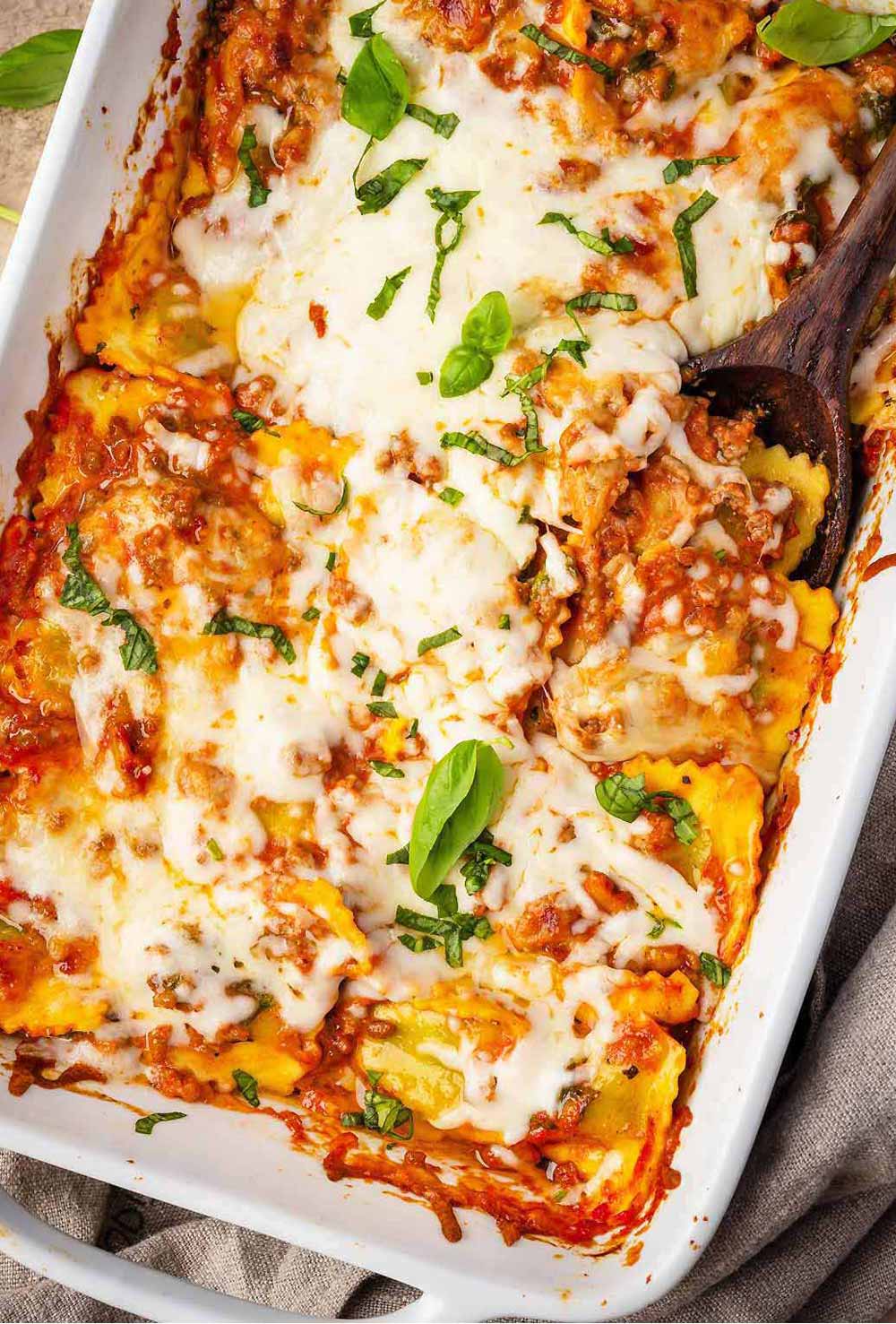
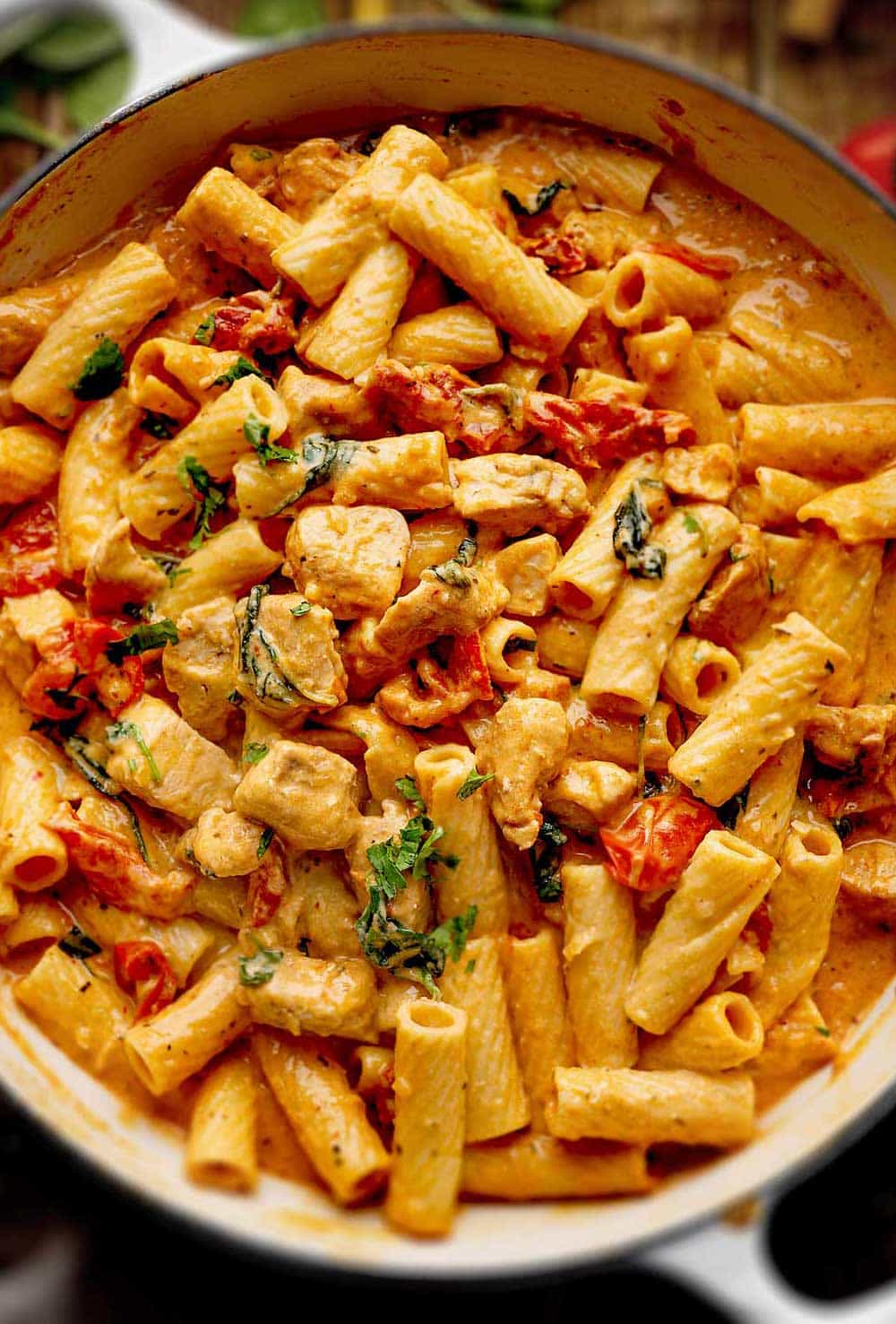


Leave a Reply